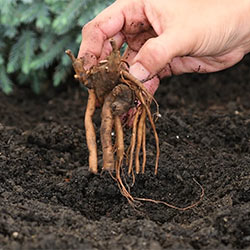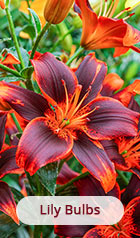Daffodil bulbs are not just associated with the legend of Narcissus, the beautiful youth who was turned into the beautiful flower but also star in poetry and stories from around the globe. Hands down, they might be one of the most culturally significant flowers in the world. Many gardeners commonly turn to daffodil
flower bulbs to grace their gardens with springtime color. Check out our daffodil bulbs to find out what all the fuss is about today!
What is the best month to plant daffodil bulbs?
Daffodil bulbs are best planted in the fall, when they'll have time to settle into the ground before the dormant season. Wait to plant your daffodil bulbs until after the weather has cooled, and the ground is no longer retaining its summer heat: in most US growing
zones, this will be in October or November. Planting daffodils too early can cause your bulbs to sprout shoots and leaves, when they should be saving up energy to use over winter.
Michigan Bulb will send you your daffodil bulbs at the proper planting time. If you're not able to plant your bulbs right away, store them in a cool, dry place to keep them from rotting, and don't leave the bulbs outdoors.
Can daffodil bulbs be planted in spring?
We get this question a lot. If you forgot to plant your bulbs in the fall, can you plant daffodil bulbs in the spring? The answer is yes, but they might not flower in the first year. We recommend planting your daffodil bulbs as soon as you remember, unless the ground is truly frozen. Planting daffodils later in fall is preferred to planting in spring!
If you need to store daffodil bulbs until spring, keep them in a cool, dry place like a basement or garage. To avoid rot, spread your bulbs in a single layer, and store them in a shallow box or paper bag. Be sure to keep a bit of space between the bulbs to allow air to circulate.
How to plant daffodil bulbs?
Daffodil bulbs are easy, easy, easy care bulbs! Daffodils are
deer resistant and cold-hardy, and planting them is very straightforward. The hardest part of daffodil planting is deciding where to put them!
Daffodils look great on their own, but they make a particularly pretty display when planted in groups of five to ten, or in mass plantings. Larger groups of bulbs allow these
perennials. to bloom in the widely spread 'spray' pattern we often picture when we think of springtime daffodils. Place a few big groups in your garden, or use taller species of daffodils as the backdrop for your other spring bulbs. Make sure to choose a sunny spot with well-drained soil in which to plant your daffodils.
Check the packaging on your daffodils to determine how far apart to set the bulbs. Loosen the soil in the planting area, and add
compost for drainage and nutrients. Then, dig holes for each daffodil bulb. Or, if you're planting a big bunch of bulbs, it may be easier to dig a trench for your bulbs, rather than digging individual holes. Set the bulbs at the depth described on the packaging, which should be two to three times the height of the bulbs, and cover them with soil. Water your daffodil bulbs and they'll enjoy a safe and cozy winter before emerging in the spring. Make sure to check our guide for more information about
how to plant bulbs
How deep to plant daffodil bulbs?
Daffodil bulbs should typically be planted at a depth equal to two to three times the height of the bulb. So, a smaller one-inch paperwhite variety will have a smaller bulb, and therefore a shorter planting depth, compared to a jumbo variety with a bulb nearly three inches tall.
When to transplant daffodils?
Daffodil bulbs should be planted in fall, but if you need to transplant your bulbs to another location, do so in the spring. Wait until the flowers have faded and the foliage has begun to yellow before digging up bulbs for transplant. Daffodil bulbs multiply underground, so when you transplant them it's also a good time to divide them, if needed. To do so, simply twist and pull smaller bulbs off the larger bulb, then replant them as you would any new bulb.
How to force daffodil bulbs?
Some varieties of daffodil, particularly paperwhites, are loved for their ability to be "forced" indoors: made to bloom in
containers at any time of the year. Daffodils are some of the most successful bulbs for forcing, so it's no surprise that they're a favorite among growers looking to try their hand at indoor flowers.
To force daffodils, you'll need to consider when you want your bulbs to flower, then count backward! The forcing process will take 17 to 20 weeks. Begin by selecting a pot with drainage holes and a depth of at least six inches. Set the daffodil bulbs in good potting soil in your pots, about an inch below the surface. Water the bulbs, then place them in a refrigerator or cold garage. After at least thirteen weeks in cold storage, move your pots to a warm, sunny room. This process will imitate spring, and your daffodils will grow and bloom!






















